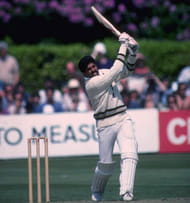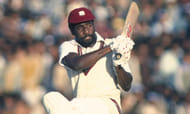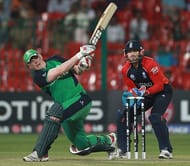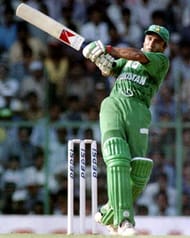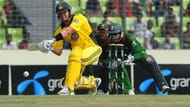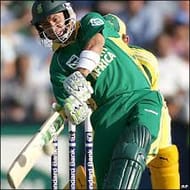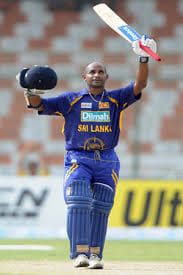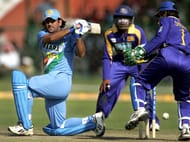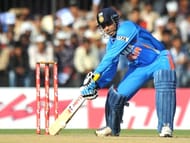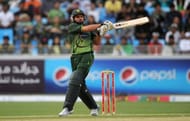Brutality seldom has a clear definition, but it is most commonly used to describe the methods used to slay any living thing – man or animal.
Cricket has also seen quite a few instances where batsmen have slain bowling attacks without a care in the world. The likes of Yuvraj Singh and Aaron Finch, bolstered by the advent of Twenty20 cricket, can decimate any side by the sheer power of their exploits with the willow.
Sachin Tendulkar started his international career on those lines, and over time, developed a refined version of the savagery that he would dish out to bowlers around the world.
Here is a look at ten of the most brutal innings ODI cricket has ever seen:
Special Mention: Collis King (86 v/s England, 1979 World Cup final)
It wasn’t every day that Viv Richards, the swaggering batsman of the seventies and eighties, ended up playing second fiddle to anyone else. But in the final of the 1979 World Cup against England, a Bajan all-rounder put him to shade with a masterly knock of his own.
Walking in with the side reeling at 99/4, Collis King set about the bowling almost immediately. He cut Ian Botham for four off his first ball, and then went after part-timers Boycott, Larkins and Willey. With Bob Willis absent due to injury, England had to gamble on the remaining 12 overs, and it proved to be their undoing.
King ignored Richards’ advice of taking it easy, and swiftly mowed down the rest of the bowling post-lunch. He fell for a well-made 86 from just 66 balls, and coupled with Richards’ 138, West Indies overcame a spirited response from captain Mike Brearley and Boycott to retain the trophy they had won four years ago.
10. Kapil Dev (175* v/s Zimbabwe, 1983)
Sometimes, all you need is an explosive batsman to knock out the opposition. In Kapil’s case, the need was dire, and the innings uninhibited.
When your side is reeling at 17/5, and both openers are back in the pavilion without a run to their names, you are in more than just a tight spot. You have a choice – either back down meekly or make a last stand.
Kapil chose the latter, and proceeded to play a gem of a knock with his rustic, free-flowing approach. The ground at Tunbridge Wells began to resemble a graveyard for the bowlers despite Rawson and Curran taking six wickets amongst themselves.
Brick by brick, the Indian captain resurrected the innings, and after reaching his hundred, he just let go. Wicket-keeper Syed Kirmani, who joined the Haryana all-rounder at No.10, played the perfect second fiddle as Kapil sent the ball into orbit or in the fence during their century partnership; in fact, his display of hitting was such that Duncan Fletcher finally ran out of ideas and Zimbabwe just went through the motions of bowling and fielding.
India eventually posted a fighting total, and bundled out the Zimbabweans despite Curran’s defiant half century. But more importantly, Kapil’s ferocious onslaught infused tons of confidence into the side as they coasted to the World Cup title.
9. Viv Richards (189* v/s England, 1984)
Blistering doesn’t even begin to describe the kind of display that The King exhibited against England in 1984 at Old Trafford.
Nothing was going right for the former world champions during their turn at the batting crease. The wicket afforded plenty of turn, and Derbyshire off-spinner Geoff Miller utilized that to his advantage. Richards found himself running out of partners with only Eldine Baptiste, Joel Garner and Michael Holding left to bat, and England had their tails up and twitching.
They forgot the cardinal rule – never underestimate the King.
In rapid succession, the right-hander unleashed a cluster of savage strokes all over the wicket, dispatching all the bowlers with arrogant disdain as he went about forging a useful stand with Baptiste, and after Garner fell cheaply, he accelerated hard in Holding’s company.
He slammed 21 fours and five huge sixes – the highlight was a straight drive that took the ball out of the park – contributing 93 out of the last 106 runs that came in partnership with Holding.
England duly went to pieces, and despite a solid half-century from Allan Lamb, they suffered a humiliating 104-run loss.
8. Kevin O’Brien (113 v/s England, 2011)
Ireland continued their trend of upsetting more fancied teams in World Cup games as they pulled off a magnificent last-over victory over England, shocking every spectator in the stands.
It almost became a no-contest when the Shamrocks lost five wickets during the mammoth run-chase, but thanks to a stocky, purple-haired all-rounder who produced the fastest century in the World Cup, they were kept in the hunt.
Kevin O’Brien, Ireland’s best hope in the middle order, unleashed a brilliant spectacle of controlled brutality as he spearheaded the green brigade’s charge towards the 300-plus target. To put it simply, his innings was breath-taking.
Not many would have dared to thump Graeme Swann through the covers off only their second ball, but Kevin really doesn’t care about reputations when he is in the zone. In fact, he went on to tonk successive sixes off the bemused off-spinner, and from then on, Ireland’s innings got a new lease of life.
Without a care in the world for fielding restrictions, O’Brien dispatched Tim Bresnan over cover – the best shot of his innings – and clobbered both James Anderson and Stuart Broad with impunity. In the process, he rocketed to his century off just 50 deliveries, with 13 fours and six monstrous hits into the stands.
He fell with his side close to victory, but by then, he had done enough damage to England’s target, confidence and reputation, and it was only a matter of time before the Shamrocks rounded off the win, bringing St Patrick’s Day early into Bangalore!
7. Saeed Anwar (194 vs India, 1997)
There are two kinds of batsmen in this world. One just stands at the crease and slogs away with gay abandon, living on the edge but scoring runs at a rapid pace.
The other mixes both caution and aggression, putting away the poor deliveries while keeping the scorecard ticking along at a fairly decent rate.
And then there is Saeed Anwar, who combines both roles with aplomb.
The Pakistani opener produced an innings that stood as a colossal record for thirteen long years. He took particular interest in leg-spinner Anil Kumble’s bag of tricks, and smashed him for 24 in a single over, punctuating it with three huge sixes.
In addition, Anwar also dispatched seamers Venkatesh Prasad, Abey Kuruvilla and Robin Singh to the fence regularly, despite suffering from cramps and heat exhaustion under the sweltering Chennai conditions. He managed to break Viv Richards’ record for the highest individual score in ODI cricket, set thirteen years ago.
Pakistan galloped to 328, and despite Rahul Dravid’s maiden ODI century, India fell behind the visitors by over thirty runs.
Incidentally, it was Sachin Tendulkar who removed Anwar for 194, and he would eventually surpass this score as well.
6. Shane Watson (185* v/s Bangladesh, 2011)
The Aussie all-rounder did not just toy around with the Bangladesh bowlers; he gave them such a spanking that they were left running for cover against his most ferocious onslaught in ODIs till date.
After wicket-keeper Mushfiqur Rahim and Shahriar Nafees made half-centuries to steer their side to a respectable total, Watson conjured an innings bereft of remorse and mercy as he single-handedly pursued the target without giving a second thought to the hiding that the bowlers received.
He favoured the leg-side for most of his powerful hits. Left-arm spinner Suhrawadi Shuvo was reduced to a wreck after the Aussie opener smashed him for four massive sixes on a slow pitch that offered plenty of turn for the slower bowlers.
Watson eventually finished on an unbeaten 185, blasting 15 fours and an equal number of sixes from just 96 balls as Australia coasted to victory by nine wickets in just 26 overs.
5. Herschelle Gibbs (175 v/s Australia, 2006)
This was savagery at its best, but it also had glimpses of perfect timing and immaculate placement.
Ricky Ponting’s Australian side piled a record 434 after making first use of the wicket at the Wanderers; the skipper himself led the way with a phenomenal century, along with vital contributions from the usual suspects. It left the South Africans needing to go at around nine an over to even think about the possibility of tying the game.
Coming in at the fall of Boeta Dippenaar, Herschelle Gibbs took charge right from the word go. He did what anyone would do under the circumstances – go for shots that build up your confidence, and keep the scoreboard motoring along. With captain Graeme Smith also deciding to go for broke, the scoring rate kept rising with each passing moment.
After the dismissals of Smith and AB de Villiers, Gibbs just stood at the batting end and hit everything offered up to him. He duly outscored Ponting, eventually falling for a magnificent 175.
His brand of power hitting was one of the key factors why Mick Lewis ended up conceding the most runs in ODI cricket, and may have also influenced the Aussie bowler’s exit from the national set up. However, it still remains one of the greatest innings in the limited-overs format, and was instrumental in the Proteas winning the game with just one ball to spare!
4. Sanath Jayasuriya (189 vs India, 2000)
In one of the greatest knocks he has ever played, Sanath Teran Jayasuriya not only helped his side post a challenging total, but put the opposition completely out of the game during the final of the Coca Cola Trophy at Sharjah in 2000.
Initially, though, nothing in Sri Lanka’s approach suggested that they were on their way to a match-winning score. They were four down after having barely crossed the 100-run mark.
Then Russel Arnold came in, and took the pressure off Jayasuriya with his calm, level-headed strategy. The skipper was encouraged, and he broke the shackles upon him with a devastating blow. From then on, it was all Jayasuriya as none of the Indian bowlers could contain him.
Unfettered, unrestricted and unhampered by anything thrown at him, the Matara Marauder plundered his last 89 runs from just 43 balls, before his opposite number had him stumped. But by then, maximum damage had been inflicted through 21 fours and four huge sixes.
Sadly for India, though, they collapsed like a pack of cards in the face of hostile bowling from Chaminda Vaas and Muttiah Muralitharan. They were bundled out for 54, without any trimmings of any sort, and only one player managed to get into double figures.
3. Mahendra Singh Dhoni (183* vs Sri Lanka, 2005)
His blitzkrieg against Pakistan brought him to the fore, but it was the long-haired Jharkhand lad’s stormy innings against Sri Lanka at Jaipur that made the world actually sit up and take notice.
Mahendra Singh Dhoni not only filled the troublesome slot of wicket-keeper, but also gave the Indian side a batsman who could wield the blade like a submachine gun, as the 1996 World Cup winners found out to their cost.
Rival wicket-keeper batsman Kumar Sangakkara had earlier scored a magnificent century to enable his side to set a challenging target, but in the face of Dhoni’s blitz, his innings was relegated to second-best.
India lost Tendulkar early in the chase, and it should have been the point at which they would have pressed the panic button in the past. But they hadn’t reckoned with Mahi.
His gameplan was simple: hit on the up, through the line, and use the feet when the ball wasn’t pitched up. Signalling his intentions with two sixes off Vaas over extra cover, Dhoni got down to business, chipping away at the target and building fruitful partnerships with the rest of the line up.
Muralitharan’s threat was negated by soft hands and quick running between the wickets, and leg-spinner Upul Chandana was treated like a net bowler, spoiling his rhythm.
Even a bout of cramps couldn’t keep Dhoni tied up, and he swiftly guided India home along with Venugopal Rao, thus ensuring that his side had a 3-0 lead in the seven-match series. Magnificent stuff!
2. Virender Sehwag (219 vs West Indies, 2012)
The Master set the mark, and the shishya went past it with his usual buccaneering ways – both landmarks were set in the same state: Madhya Pradesh.
A little over two years ago, Sachin Tendulkar scored the first double hundred in men’s limited-overs cricket – a record that one hoped could never be broken by anyone else.
But Virender Sehwag, Sachin’s opening partner and a power hitter in his own right, had other ideas.
Against the West Indies, the Delhi batsman played a blistering innings – he set the pace by hitting his second ball for four, and never looked back. He even deposited wily off spinner Sunil Narine’s first ball into the stands, shocking the rest of the Windies squad, before thumping Darren Sammy over extra cover.
Favouring the arc between mid-wicket and long-on for the big hits, Sehwag peppered the backward point fence for the boundaries, preferring to play square of the wicket for the ground strokes. He equaled, then broke, Sachin’s mark with crisply struck fours, and eventually fell for 219.
Denesh Ramdin’s heroics went in vain as the West Indies crumbled under the Najafgarh Bomber’s assault to surrender by 153 runs.
1. Shahid Afridi (102 vs Sri Lanka, 1996)
When you get to bat for the first time in only your second international game, you tend to be a bit watchful. You want to score as many runs as you can while staying in for as long as possible.
Shahid Afridi, the teenage leg-spinner, ignored the first thought in favour of the second, and to his credit, it worked well.
The 16-year old launched into the Sri Lankan attack from the word go, sending his second ball into the stands. From then on, the pinch hitter turned the game completely in his side’s favour.
With veteran batsman Saeed Anwar watching from the other end, Afridi completely cut loose, singling out the left-arm spin of Sanath Jayasuriya for special treatment. In the two overs that the Sri Lankan bowled to him, the teenager plundered 41 runs without so much as the blink of an eye.
He repeatedly danced down the track against the spinners, even flummoxing the old fox Muttiah Muralitharan, and used his powerful forearms to devastating effect.
When he was finally dismissed, Afridi had scored exactly 102 runs from just forty balls, having reached his maiden ODI hundred in 37. He smashed 11 sixes, most of which landed in the car park, and half-a-dozen boundaries, as Sri Lanka bled runs like gushing waterfalls.
For the record, Anwar also chipped in with another century, lifting Pakistan to beyond 350. Aravinda de Silva’s three-figure knock brought the Lankans close, but the mountain of runs was too steep to climb, and they eventually fell short by 82 runs.
Brand-new app in a brand-new avatar! Download CricRocket for fast cricket scores, rocket flicks, super notifications and much more! 🚀☄️
